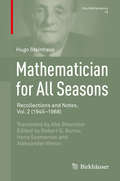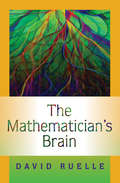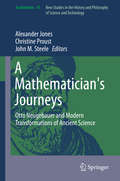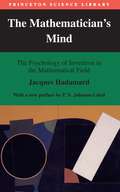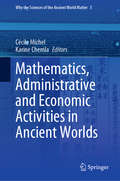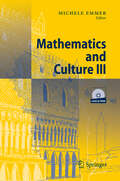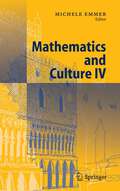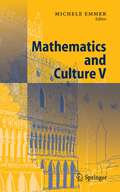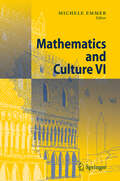- Table View
- List View
Mathematician for All Seasons: Recollections and Notes, Vol. 2 (1945–1968) (Vita Mathematica #19)
by Hugo SteinhausThis book presents, in his own words, the life of Hugo Steinhaus (1887–1972), noted Polish mathematician of Jewish background, educator, and mathematical popularizer. A student of Hilbert, a pioneer of the foundations of probability and game theory, and a contributor to the development of functional analysis, he was one of those instrumental to the extraordinary flowering of Polish mathematics before and after World War I. In particular, it was he who “discovered” the great Stefan Banach. Exhibiting his great integrity and wit, Steinhaus’s personal story of the turbulent times he survived – including two world wars and life postwar under the Soviet heel – cannot but be of consuming interest. His recounting of the fearful years spent evading Nazi terror is especially moving. The steadfast honesty and natural dignity he maintained while pursuing a life of demanding scientific and intellectual enquiry in the face of encroaching calamity and chaos show him to be truly a mathematician for all seasons.The present work will be of great interest not only to mathematicians wanting to learn some of the details of the mathematical blossoming that occurred in Poland in the first half of the 20th century, but also to anyone wishing to read a first-hand account of the history of those unquiet times in Europe – and indeed world-wide – by someone of uncommon intelligence and forthrightness situated near an eye of the storm.
A Mathematician Grappling with His Century
by Laurent SchwartzLaurent Schwartz is one of the most remarkable intellects of the 20th century. His discovery of distributions, one of the most beautiful theories in mathematics, earned him a 1950 Fields Medal. Beyond this formidable achievement, his love for science and for teaching led him to think deeply and lecture broadly to the general public on the significance of science and mathematics to the well-being of the world. At the same time, his commitment to the social good, even at the expense of his beloved research, proved a moral compass throughout his life. The fight for human rights and his major role in the battle against the wars in Algeria and Vietnam were typical of matters close to his heart. The story of his life in the context of his century provides for future generations an inspiring testimonial from an extraordinary mathematician and thinker. Laurent Schwartz is a strategist of ideas, within mathematics and without. He is a great communicator who has drawn huge audiences and conveyedto them the fragrance of research, or the joy of teaching, or the value of freedom. His is a mind whose company is never dull. He belongs to the great libertarian tradition of France. And his book has the very French characteristic of giving serious consideration to the life of the intellect. No man's life can be encompassed in one telling, yet the spirit of the man and his times are well caught in his autobiography. (K. Chandrasekharan, Notices of the AMS)
A Mathematician Reads the Newspaper
by John Allen PaulosIn this lively volume, mathematician John Allen Paulos employs his singular wit to guide us through an unlikely mathematical jungle-the pages of the daily newspaper. From the Senate and sex to celebrities and cults, Paulos takes stories that may not seem to involve math at all and demonstrates how mathematical naïveté can put readers at a distinct disadvantage. Whether he's using chaos theory to puncture economic and environmental predictions, applying logic to clarify the hazards of spin doctoring and news compression, or employing arithmetic and common sense to give us a novel perspective on greed and relationships, Paulos never fails to entertain and enlighten.
Mathematicians and their Gods: Interactions between mathematics and religious beliefs
by Snezana Lawrence Mark McCartneyTo open a newspaper or turn on the television it would appear that science and religion are polar opposites - mutually exclusive bedfellows competing for hearts and minds. There is little indication of the rich interaction between religion and science throughout history, much of which continues today. From ancient to modern times, mathematicians have played a key role in this interaction. This is a book on the relationship between mathematics and religious beliefs. It aims to show that, throughout scientific history, mathematics has been used to make sense of the 'big' questions of life, and that religious beliefs sometimes drove mathematicians to mathematics to help them make sense of the world. Containing contributions from a wide array of scholars in the fields of philosophy, history of science and history of mathematics, this book shows that the intersection between mathematics and theism is rich in both culture and character. Chapters cover a fascinating range of topics including the Sect of the Pythagoreans, Newton's views on the apocalypse, Charles Dodgson's Anglican faith and Gödel's proof of the existence of God.
Mathematicians and their Gods: Interactions between mathematics and religious beliefs
by Snezana Lawrence Mark McCartneyTo open a newspaper or turn on the television it would appear that science and religion are polar opposites - mutually exclusive bedfellows competing for hearts and minds. There is little indication of the rich interaction between religion and science throughout history, much of which continues today. From ancient to modern times, mathematicians have played a key role in this interaction. This is a book on the relationship between mathematics and religious beliefs. It aims to show that, throughout scientific history, mathematics has been used to make sense of the 'big' questions of life, and that religious beliefs sometimes drove mathematicians to mathematics to help them make sense of the world. Containing contributions from a wide array of scholars in the fields of philosophy, history of science and history of mathematics, this book shows that the intersection between mathematics and theism is rich in both culture and character. Chapters cover a fascinating range of topics including the Sect of the Pythagoreans, Newton's views on the apocalypse, Charles Dodgson's Anglican faith and Gödel's proof of the existence of God.
Mathematicians at war: Volterra and his French colleagues in World War I (Archimedes #22)
by Laurent Mazliak Rossana TazzioliNumerous scientists have taken part in the war effort during World War I, but few gave it the passionate energy of the prominent Italian mathematician Volterra. As a convinced supporter of the cause of Britain and France, he struggled vigorously to carry Italy into the war in May 1915 and then developed a frenetic activity to support the war effort, going himself to the front, even though he was 55. This activity found an adequate echo with his French colleagues Borel, Hadamard and Picard. The huge correspondence they exchanged during the war, gives an extraordinary view of these activities, and raises numerous fundamental questions about the role of a scientist, and particularly a mathematician during WW I. It also offers a vivid documentation about the intellectual life of the time ; Volterra’s and Borel’s circles in particular were extremely wide and the range of their interests was not limited to their field of specialization. The book proposes the complete transcription of the aforementioned correspondence, annotated with numerous footnotes to give details on the contents. It also offers a general historical introduction to the context of the letters and several complements on themes related to the academic exchanges between France and Italy during the war.
The Mathematician's Brain: A Personal Tour Through the Essentials of Mathematics and Some of the Great Minds Behind Them
by David RuelleThe Mathematician's Brain poses a provocative question about the world's most brilliant yet eccentric mathematical minds: were they brilliant because of their eccentricities or in spite of them? In this thought-provoking and entertaining book, David Ruelle, the well-known mathematical physicist who helped create chaos theory, gives us a rare insider's account of the celebrated mathematicians he has known-their quirks, oddities, personal tragedies, bad behavior, descents into madness, tragic ends, and the sublime, inexpressible beauty of their most breathtaking mathematical discoveries. Consider the case of British mathematician Alan Turing. Credited with cracking the German Enigma code during World War II and conceiving of the modern computer, he was convicted of "gross indecency" for a homosexual affair and died in 1954 after eating a cyanide-laced apple--his death was ruled a suicide, though rumors of assassination still linger. Ruelle holds nothing back in his revealing and deeply personal reflections on Turing and other fellow mathematicians, including Alexander Grothendieck, René Thom, Bernhard Riemann, and Felix Klein. But this book is more than a mathematical tell-all. Each chapter examines an important mathematical idea and the visionary minds behind it. Ruelle meaningfully explores the philosophical issues raised by each, offering insights into the truly unique and creative ways mathematicians think and showing how the mathematical setting is most favorable for asking philosophical questions about meaning, beauty, and the nature of reality. The Mathematician's Brain takes you inside the world--and heads--of mathematicians. It's a journey you won't soon forget.
Mathematicians Fleeing from Nazi Germany: Individual Fates and Global Impact
by Reinhard Siegmund-SchultzeThe emigration of mathematicians from Europe during the Nazi era signaled an irrevocable and important historical shift for the international mathematics world. Mathematicians Fleeing from Nazi Germany is the first thoroughly documented account of this exodus. In this greatly expanded translation of the 1998 German edition, Reinhard Siegmund-Schultze describes the flight of more than 140 mathematicians, their reasons for leaving, the political and economic issues involved, the reception of these emigrants by various countries, and the emigrants' continuing contributions to mathematics. The influx of these brilliant thinkers to other nations profoundly reconfigured the mathematics world and vaulted the United States into a new leadership role in mathematics research. Based on archival sources that have never been examined before, the book discusses the preeminent emigrant mathematicians of the period, including Emmy Noether, John von Neumann, Hermann Weyl, and many others. The author explores the mechanisms of the expulsion of mathematicians from Germany, the emigrants' acculturation to their new host countries, and the fates of those mathematicians forced to stay behind. The book reveals the alienation and solidarity of the emigrants, and investigates the global development of mathematics as a consequence of their radical migration. An in-depth yet accessible look at mathematics both as a scientific enterprise and human endeavor, Mathematicians Fleeing from Nazi Germany provides a vivid picture of a critical chapter in the history of international science.
Mathematicians Fleeing from Nazi Germany: Individual Fates and Global Impact
by Reinhard Siegmund-SchultzeThe emigration of mathematicians from Europe during the Nazi era signaled an irrevocable and important historical shift for the international mathematics world. Mathematicians Fleeing from Nazi Germany is the first thoroughly documented account of this exodus. In this greatly expanded translation of the 1998 German edition, Reinhard Siegmund-Schultze describes the flight of more than 140 mathematicians, their reasons for leaving, the political and economic issues involved, the reception of these emigrants by various countries, and the emigrants' continuing contributions to mathematics. The influx of these brilliant thinkers to other nations profoundly reconfigured the mathematics world and vaulted the United States into a new leadership role in mathematics research. Based on archival sources that have never been examined before, the book discusses the preeminent emigrant mathematicians of the period, including Emmy Noether, John von Neumann, Hermann Weyl, and many others. The author explores the mechanisms of the expulsion of mathematicians from Germany, the emigrants' acculturation to their new host countries, and the fates of those mathematicians forced to stay behind. The book reveals the alienation and solidarity of the emigrants, and investigates the global development of mathematics as a consequence of their radical migration. An in-depth yet accessible look at mathematics both as a scientific enterprise and human endeavor, Mathematicians Fleeing from Nazi Germany provides a vivid picture of a critical chapter in the history of international science.
Mathematicians in Bologna 1861–1960
by Salvatore CoenThe scientific personalities of Luigi Cremona, Eugenio Beltrami, Salvatore Pincherle, Federigo Enriques, Beppo Levi, Giuseppe Vitali, Beniamino Segre and of several other mathematicians who worked in Bologna in the century 1861–1960 are examined by different authors, in some cases providing different view points. Most contributions in the volume are historical; they are reproductions of original documents or studies on an original work and its impact on later research. The achievements of other mathematicians are investigated for their present-day importance.
A Mathematician's Journeys: Otto Neugebauer and Modern Transformations of Ancient Science (Archimedes #45)
by Alexander Jones Christine Proust John M. SteeleThis book explores facets of Otto Neugebauer's career, his impact on the history and practice of mathematics, and the ways in which his legacy has been preserved or transformed in recent decades, looking ahead to the directions in which the study of the history of science will head in the twenty-first century. Neugebauer, more than any other scholar of recent times, shaped the way we perceive premodern science. Through his scholarship and influence on students and collaborators, he inculcated both an approach to historical research on ancient and medieval mathematics and astronomy through precise mathematical and philological study of texts, and a vision of these sciences as systems of knowledge and method that spread outward from the ancient Near Eastern civilizations, crossing cultural boundaries and circulating over a tremendous geographical expanse of the Old World from the Atlantic to India.
The Mathematician's Mind: The Psychology of Invention in the Mathematical Field (Princeton Science Library #18)
by Jacques HadamardFifty years ago when Jacques Hadamard set out to explore how mathematicians invent new ideas, he considered the creative experiences of some of the greatest thinkers of his generation, such as George Polya, Claude Lévi-Strauss, and Albert Einstein. It appeared that inspiration could strike anytime, particularly after an individual had worked hard on a problem for days and then turned attention to another activity. In exploring this phenomenon, Hadamard produced one of the most famous and cogent cases for the existence of unconscious mental processes in mathematical invention and other forms of creativity. Written before the explosion of research in computers and cognitive science, his book, originally titled The Psychology of Invention in the Mathematical Field, remains an important tool for exploring the increasingly complex problem of mental life. The roots of creativity for Hadamard lie not in consciousness, but in the long unconscious work of incubation, and in the unconscious aesthetic selection of ideas that thereby pass into consciousness. His discussion of this process comprises a wide range of topics, including the use of mental images or symbols, visualized or auditory words, "meaningless" words, logic, and intuition. Among the important documents collected is a letter from Albert Einstein analyzing his own mechanism of thought.
The Mathematician's Mind: The Psychology of Invention in the Mathematical Field (Princeton Science Library #109)
by Jacques HadamardFifty years ago when Jacques Hadamard set out to explore how mathematicians invent new ideas, he considered the creative experiences of some of the greatest thinkers of his generation, such as George Polya, Claude Lévi-Strauss, and Albert Einstein. It appeared that inspiration could strike anytime, particularly after an individual had worked hard on a problem for days and then turned attention to another activity. In exploring this phenomenon, Hadamard produced one of the most famous and cogent cases for the existence of unconscious mental processes in mathematical invention and other forms of creativity. Written before the explosion of research in computers and cognitive science, his book, originally titled The Psychology of Invention in the Mathematical Field, remains an important tool for exploring the increasingly complex problem of mental life. The roots of creativity for Hadamard lie not in consciousness, but in the long unconscious work of incubation, and in the unconscious aesthetic selection of ideas that thereby pass into consciousness. His discussion of this process comprises a wide range of topics, including the use of mental images or symbols, visualized or auditory words, "meaningless" words, logic, and intuition. Among the important documents collected is a letter from Albert Einstein analyzing his own mechanism of thought.
Mathematicians' Reflections on Teaching: A Symbiosis with Mathematics Education Theories (Advances in Mathematics Education)
by Sepideh StewartThis book opens the case on collaboration among mathematicians and mathematics educators. The authors of this book provide their research and experience based insights on collaboration to inspire the young generation of the mathematics community to engage in productive collaborations and exchange of knowledge early in their careers. These valuable collaborations are anticipated to generate innovative research questions that set new and novel paths for mathematics education research with ample possibilities yet to be realized and discovered.
Mathematicians under the Nazis
by Sanford L. SegalContrary to popular belief--and despite the expulsion, emigration, or death of many German mathematicians--substantial mathematics was produced in Germany during 1933-1945. In this landmark social history of the mathematics community in Nazi Germany, Sanford Segal examines how the Nazi years affected the personal and academic lives of those German mathematicians who continued to work in Germany. The effects of the Nazi regime on the lives of mathematicians ranged from limitations on foreign contact to power struggles that rattled entire institutions, from changed work patterns to military draft, deportation, and death. Based on extensive archival research, Mathematicians under the Nazis shows how these mathematicians, variously motivated, reacted to the period's intense political pressures. It details the consequences of their actions on their colleagues and on the practice and organs of German mathematics, including its curricula, institutions, and journals. Throughout, Segal's focus is on the biographies of individuals, including mathematicians who resisted the injection of ideology into their profession, some who worked in concentration camps, and others (such as Ludwig Bieberbach) who used the "Aryanization" of their profession to further their own agendas. Some of the figures are no longer well known; others still tower over the field. All lived lives complicated by Nazi power. Presenting a wealth of previously unavailable information, this book is a large contribution to the history of mathematics--as well as a unique view of what it was like to live and work in Nazi Germany.
Mathematics: From Creating the Pyramids to Exploring Infinity (Arcturus Fundamentals)
by Anne RooneyIn order to understand the universe you must know the language in which it is written. And that language is mathematics. - Galileo (1564-1642)People have always sought order in the apparent chaos of the universe. Mathematics has been our most valuable tool in that search, uncovering the patterns and rules that govern our world and beyond. This book traces humankind's greatest achievements, plotting a journey through the mathematical intellects of the last 4,000 years to where we stand today.It features the giants of mathematics, from Euclid and Pythagoras, through Napier and Newton, to Leibniz, Riemann, Russell, and many more.Topics include: • Counting and measuring from the earliest times• The Ancient Egyptians and geometry• The movements of planets• Measuring and mapping the world• Fuzzy logic and set theory• The death of numbersABOUT THE SERIES: Arcturus Fundamentals Series explains fascinating and far-reaching topics in simple terms. Designed with rustic, tactile covers and filled with dynamic illustrations and fact boxes, these books will help you quickly get to grips with complex topics that affect our day-to-day living.
Mathematics Across Cultures: The History of Non-Western Mathematics (Science Across Cultures: The History of Non-Western Science #2)
by Ubiratan D'AmbrosioMathematics Across Cultures: A History of Non-Western Mathematics consists of essays dealing with the mathematical knowledge and beliefs of cultures outside the United States and Europe. In addition to articles surveying Islamic, Chinese, Native American, Aboriginal Australian, Inca, Egyptian, and African mathematics, among others, the book includes essays on Rationality, Logic and Mathematics, and the transfer of knowledge from East to West. The essays address the connections between science and culture and relate the mathematical practices to the cultures which produced them. Each essay is well illustrated and contains an extensive bibliography. Because the geographic range is global, the book fills a gap in both the history of science and in cultural studies. It should find a place on the bookshelves of advanced undergraduate students, graduate students, and scholars, as well as in libraries serving those groups.
Mathematics, Administrative and Economic Activities in Ancient Worlds (Why the Sciences of the Ancient World Matter #5)
by Cécile Michel Karine ChemlaThis book focuses on the ancient Near East, early imperial China, South-East Asia, and medieval Europe, shedding light on mathematical knowledge and practices documented by sources relating to the administrative and economic activities of officials, merchants and other actors. It compares these to mathematical texts produced in related school contexts or reflecting the pursuit of mathematics for its own sake to reveal the diversity of mathematical practices in each of these geographical areas of the ancient world. Based on case studies from various periods and political, economic and social contexts, it explores how, in each part of the world discussed, it is possible to identify and describe the different cultures of quantification and computation as well as their points of contact. The thirteen chapters draw on a wide variety of texts from ancient Near East, China, South-East Asia and medieval Europe, which are analyzed by researchers from various fields, including mathematics, history, philology, archaeology and economics. The book will appeal to historians of science, economists and institutional historians of the ancient and medieval world, and also to Assyriologists, Indologists, Sinologists and experts on medieval Europe.
Mathematics and Culture II: Visual Perfection: Mathematics and Creativity
by Michele EmmerIn addition to mathematicians, this book is intended for a more general audience, for teachers and for researchers, for students in almost all topics, in particular in art, humanities, psychology, design and literature It is a truly interdisciplinary volume, and serves as a source for ideas and suggestions in several fields
Mathematics and Culture III
This work contains the proceedings of the "Mathematics and Culture" conference held in Venice in March 2002. The conference aims to act as a bridge across the various aspects of human knowledge. While keeping mathematics as its core, it is aimed at anyone endowed with cultural curiosity and interests, whether within or (even more so) outside mathematics. This volume therefore covers music, cinema, art, theatre and literature, with topics ranging from Tibet to comics.
Mathematics and Culture IV
Gaudi’s dream which will be reached finalizing the construction of the "Sagrada Familia" in Barcelona, the victory of the Swiss sail boat "Alinghi", which won America’s Cup, films such as " A Beautiful Mind" and "Enigma", the theatrical play based on the life of Galois, the images of the Dutch graphic artist M. C. Escher, crypotography, comics. What all these topics have in common? Mathematics, of course. This book focuses on the important role of mathematics in culture. It shows how very complex links between mathematics and culture can be not only interesting and stimulating but also fun.
Mathematics and Culture V
“I mean the third”cried the old man taking up the geometry book. “Well, young lady…”and he bent over his daughter. The princess gazed with terror into her father's keen eyes. He, on his part, got angry – pushed away his chair, dragged it back with a cl- ter – trying all the while to control himself; then again he would break out and storm, and wish the whole thing to the devil. As ill-luck would have it, to-day again his daughter answered at random and wrongly. “What an idiot!”he exclaimed, flinging down the book. The he rose, walked up and down, came back and stroked his daughter's hair, sat down again, and began his explanation once more. “It does not do, princess, it does not do”, he said, seeing her rise to leave him with VII the book in her hand. “Mathematics is a noble science, and I do not want you to be just like all the silly young ladies one meets. Persevere and you will learn to like the work, and the dullness will be nocked out of your brain. ” These words were spoken by Prince Andrei Bolkonskij, who was talking to Princess Marja Bolokonskaja, his daughter. They are two of the protagonists of Lev Tolstoy’s War and Peace, finished in 1869.
Mathematics and Information in the Philosophy of Michel Serres (Michel Serres and Material Futures)
by Vera BühlmannThis book introduces the reader to Serres' unique manner of 'doing philosophy' that can be traced throughout his entire oeuvre: namely as a novel manner of bearing witness.It explores how Serres takes note of a range of epistemologically unsettling situations, which he understands as arising from the short-circuit of a proprietary notion of capital with a praxis of science that commits itself to a form of reasoning which privileges the most direct path (simple method) in order to expend minimal efforts while pursuing maximal efficiency. In Serres' universal economy, value is considered as a function of rarity, not as a stock of resources. This book demonstrates how Michel Serres has developed an architectonics that is coefficient with nature.Mathematic and Information in the Philosophy of Michel Serres acquaints the reader with Serres' monist manner of addressing the universality and the power of knowledge – that is at once also the anonymous and empty faculty of incandescent, inventive thought.The chapters of the book demarcate, problematize and contextualize some of the epistemologically unsettling situations Serres addresses, whilst also examining the particular manner in which he responds to and converses with these situations.
Mathematics and Information in the Philosophy of Michel Serres (Michel Serres and Material Futures)
by Vera BühlmannThis book introduces the reader to Serres' unique manner of 'doing philosophy' that can be traced throughout his entire oeuvre: namely as a novel manner of bearing witness.It explores how Serres takes note of a range of epistemologically unsettling situations, which he understands as arising from the short-circuit of a proprietary notion of capital with a praxis of science that commits itself to a form of reasoning which privileges the most direct path (simple method) in order to expend minimal efforts while pursuing maximal efficiency. In Serres' universal economy, value is considered as a function of rarity, not as a stock of resources. This book demonstrates how Michel Serres has developed an architectonics that is coefficient with nature.Mathematic and Information in the Philosophy of Michel Serres acquaints the reader with Serres' monist manner of addressing the universality and the power of knowledge – that is at once also the anonymous and empty faculty of incandescent, inventive thought.The chapters of the book demarcate, problematize and contextualize some of the epistemologically unsettling situations Serres addresses, whilst also examining the particular manner in which he responds to and converses with these situations.
